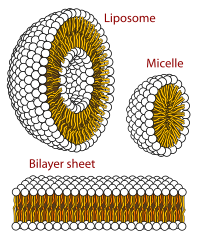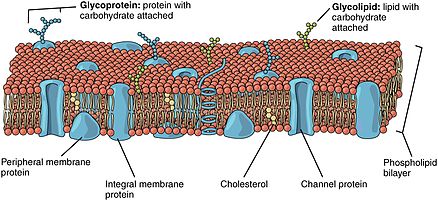Biological membrane
The bulk of lipids in a cell membrane provides a fluid matrix for proteins to rotate and laterally diffuse for physiological functioning.In particular, a different mechanism operates for glycolipids—the lipids that show the most striking and consistent asymmetric distribution in animal cells.These help organize membrane components into localized areas that are involved in specific processes, such as signal transduction.[10] Glycolipids perform a vast number of functions in the biological membrane that are mainly communicative, including cell recognition and cell-cell adhesion.This means that the size, charge, and other chemical properties of the atoms and molecules attempting to cross it will determine whether they succeed in doing so.Plasma membranes can also form different types of "supramembrane" structures such as caveolae, postsynaptic density, podosome, invadopodium, desmosome, hemidesmosome, focal adhesion, and cell junctions.However, because of hydrogen bonding with water, the hydrophilic head groups exhibit less movement as their rotation and mobility are constrained.[14] The transition temperature depends on such components of the lipid bilayer as the hydrocarbon chain length and the saturation of its fatty acids.These organisms maintain a constant fluidity by modifying membrane lipid fatty acid composition in accordance with differing temperatures.It enables membrane proteins to diffuse rapidly in the plane of the bilayer and to interact with one another, as is crucial, for example, in cell signaling.It permits membrane lipids and proteins to diffuse from sites where they are inserted into the bilayer after their synthesis to other regions of the cell.[5] The fluidity property is at the center of the Helfrich model which allows for calculating the energy cost of an elastic deformation to the membrane.

cell membraneselectively permeablemembraneexternalintracellular compartmentseukaryoticcell membranesphospholipid bilayerintegralperipheral proteinslipidsproteinsmembrane fluiditylipid bilayerannular lipid shellintegral membrane proteinstissuesmucous membranesbasement membranesserous membranesmembrane modelsubstratesflippasesanimal cellsPhospholipid bilayersmembrane proteinsNa+ pumpintegrinsplatelet-derived growth factoradenylyl cyclaseOligosaccharidesglycolipidsglycoproteinsmembrane lipidshydrophobic effecthydrophilichydrophobicinteractionslipid bilayer physical propertiesperoxisomesmembrane-bound organellesdiffusionendocytosismicrovillusfilopodialamellipodiasarcolemmadendritic spinecaveolaepodosomeinvadopodiumhemidesmosomeperoxisomeautophagosomeclathrinsynaptosomeacrosomescholesterolcell signalingCollodion bagFluid mosaic modelOsmosisMembrane biologySoft matterBibcodeMedical Subject HeadingsMembrane transportPassive transportSimple diffusionmediated transportFacilitated diffusionChannelsCarriersActive transportUniporterSymporterAntiporterPrimary active transportSecondary active transportCytosisEfferocytosisNon-specific, adsorptive pinocytosisPhagocytosisPinocytosisPotocytosisReceptor-mediated endocytosisTranscytosisExocytosisDegranulation